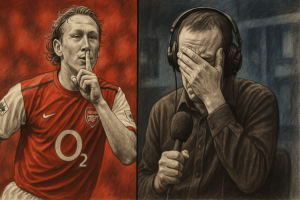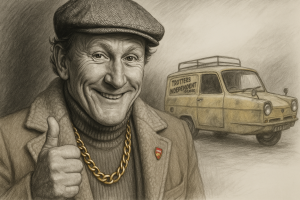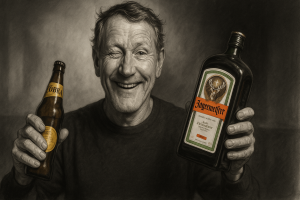“It’s only Ray Parlour.”
Those words, tossed into the air by a grinning Tim Lovejoy, were meant in jest. A quip. A wink. A throwaway line lost in the tide of the cup final. But football has a way of turning punchlines into poetry. For as the ball descended from the heavens that sunlit day in Cardiff, Ray Parlour met it with the purest of right-footed sermons — and sent it soaring into the Chelsea net with the certainty of scripture.
Carlo Cudicini, stunned. Chelsea, shellshocked. Arsenal, delirious.
And Ray Parlour? Arms aloft, sprinting into immortality.
That strike — that swing — that moment is his. Forever. One of the FA Cup’s great final goals. Up there with Charlie George collapsing in ecstasy. With Alan Sunderland’s last-gasp lunge. It was the day Ray Parlour wrote his name in calligraphy across Arsenal’s modern history.
But to distill Parlour’s Arsenal life into a single, sun-drenched strike would be to do him a disservice. A career of twelve years. Over 450 appearances. Trophies, tackles, and tireless toil. He gave too much — far too much — to be remembered for just one swing of the boot, however beautiful.

It began in 1992, in the shadow of Highbury’s marble halls, amid a very different Arsenal. Gone were the title charges of ’89 and ’91 — Manchester United were rising, Liverpool waning. George Graham’s empire was changing, becoming something grittier, more pragmatic. And into this world stepped a wiry lad from Romford. Curly hair, strawberry-blonde locks, a grin as wide as the North Bank. Ray Parlour.
Parlour was the latest midfielder that Arsenal had churned out from Hale End. Before him came Davis and Rocastle — names woven into the club’s soul. But Parlour arrived with that same sense of local wonder. One of us. And we loved him for it — even before he’d earned it. Because that’s what we do when a boy becomes a Gunner.
The early ’90s were a curious time. A team built in the image of its manager — stern, uncompromising, battle-hardened. Adams, Bould, Winterburn, Dixon. Smith and Campbell. Merson, magic and mischief. Arsenal weren’t beautiful, but they were brutal. They played with clenched fists and pounding hearts. They grinded. They fought. And Ray Parlour? He fit right in.
He lifted silver early — the domestic cup double of 1993, a curious quirk against the same opponent twice, Sheffield Wednesday. A year later, he held aloft a European trophy, even if Copenhagen saw him unused. But already, the boy had become a man among men. He belonged.
Yet what makes Ray Parlour’s story so utterly compelling is not merely his beginning — it is his survival.
You see, when Arsène Wenger walked through the door, football changed. Science arrived. Nutrition. Sophistication. Continentalism. The culture shifted. And many feared that those steeped in the old Arsenal might be left behind.
But not Ray Parlour.
He didn’t just adapt. He excelled.
Under Wenger’s new doctrine of style and substance, Parlour became something more. He had always been lungs and legs — now he had learning and lightness. He ran like a man chasing eternity, yes — but now, he passed with purpose, he moved with meaning. Surrounded by Bergkamp’s ballet, Vieira’s violence, Pires’ poetry and Ljungberg’s line-breaking brilliance, Parlour became the English heartbeat in a European juggernaut.
He did not dazzle. He endured.
He did not swerve past defenders. He wore them down.
He did not crave acclaim. He craved the cause.
In an age of artistry, Ray Parlour remained the anthem of effort. He was the clatter before the crescendo. The grit beneath the glitter. And when Arsenal needed to dig in — when the shine dulled and the shirts muddied — it was Parlour who rose, sleeves rolled, spirit unbowed.
It is easy now to forget how rare his balance was. Football went one way — Ray bridged both. The old guard and the new wave. From pub culture to protein shakes. From hangovers to heat maps. He played through it all, and with a smile that suggested he’d have paid for the privilege.

He didn’t just survive the transition. He thrived in it.
He became a champion, a Double winner, an Invincible. One of only a handful of homegrown players to be part of the season without defeat. He earned his place in the pantheon not by grace, but by graft. By doing the thankless work, so others could paint masterpieces.
And if medals are the measure, few from Hale End have matched him. Three Premier League titles. Four FA Cups. One UEFA Cup Winners’ Cup. A community shield or two for good measure. And countless memories written in gold.
And even now, as I find myself swept away in the reverie of Ray Parlour’s relentless spirit — that functional, unfashionable, indispensable virtue — I must pause. Because to cast him solely as the mud-splattered engine of a glittering machine would be to do him a cruel disservice. Yes, he grafted. Yes, he grafted like few ever have. But the truth — the glorious truth — is that Ray Parlour could play.
You do not survive the steely rigour of George Graham’s regimented Arsenal and then glide into the Arsène Wenger revolution unless you have more than lungs and loyalty. You must have a football brain. You must have a football soul. And Ray Parlour had both — tucked humbly beneath that tousled mop of curls and behind those unassuming Essex eyes.
He scored a shade over thirty goals across a storied career, but when they came, they did not tiptoe in — they thundered. We have already sung of Cardiff. But there was also Valencia — a Champions League night that cried out for a hero, and Parlour responded with a howitzer that belonged to a different species of midfielder. And Newcastle — yes, Newcastle. I was there. East Stand. Three goals. One Ray Parlour, resplendent. A hat-trick from the least likely magician. That afternoon, the Emirates had not yet been built, but Parlour built a memory that lives forever.
Who took man of the match in the FA Cup Final at Wembley in ’98? When Newcastle were swept aside and the double was restored to its rightful North London home? Ray did.
Who led Arsenal into the cauldron of the San Siro? Then presided over the annihilation of Internazionale on their own turf, an evening that felt like a continental coronation? Ray did.
So no, he was not just a cog in a machine. He had his moments in the sun. He earned them. He stole them. He deserved them.
And so, let it not be said that Ray Parlour was simply the tireless workhorse with a big heart — though he was. Let it also be said that he was, at times, the conjurer. The captain. The match-winner. The man who made the music as well as carried the drums.

Even now, long after the final whistle of his playing days, he remains ours. Still talking Arsenal. Still loving Arsenal. The boy who became a man — and then became folklore. You’ll find him now not on the pitch, but on the airwaves — laughter and love for the club that made him. A Jaeger here. A Cobra there all of course to compliment his Ruby Murray.
He’s affectionately known as “The Romford Pelé” — a nickname born of irony, but kept alive by adoration. He was never the poster boy. Not the Panini sticker you’d swap last in the playground. But he was the player we all felt we knew. The one who played for the badge, not the back page.
He may not be the first name in your best-ever XI. He may not have adorned bedroom walls. But he was real. Authentic. Unfiltered. And in a club famed for its style, he was part of its soul.
From Hale End to Premier League heaven, Ray Parlour gave everything. He left nothing behind. Not one ounce of energy. Not one moment shirked. He may have deserved more England caps — but he earned every Arsenal cheer.
And in return, we give him this:
Our everlasting thanks.
Our unwavering affection.
Our Romford Pelé — forever one of us.
Thank you, Ray.
Victoria Concordia Crescit
